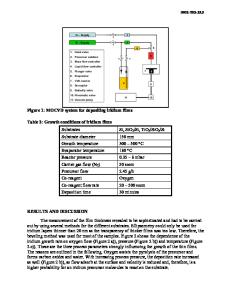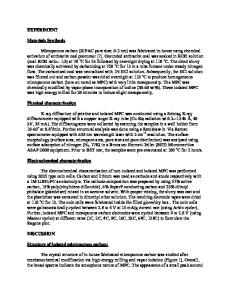Iridium Based Electrodes for Ferroelectric Capacitor Fabrication
- PDF / 476,644 Bytes
- 6 Pages / 612 x 792 pts (letter) Page_size
- 4 Downloads / 383 Views
Iridium Based Electrodes for Ferroelectric Capacitor Fabrication J. A. Johnson, J. G. Lisoni, and D. J. Wouters IMEC vzw, 3000 Leuven, Belgium Abstract Ir and its conductive oxide, IrO2, are candidates to replace Pt as the electrodes in ferroelectric capacitors (FECAPs) because of improved endurance (since e.g. Pt/PZT/Pt shows strong fatigue) and also because of the oxygen barrier properties of Ir/IrO2 stacks that enable the fabrication of stacked FECAPs on top of contact plugs. Two important issues related to these electrodes are the control of the ferroelectric layer orientation on top of these materials, as well as material stability (e.g. oxidation and possible growth of large IrO2 crystallites). In this work, we show that IrO2 bottom electrodes affect the crystallization of sol-gel deposited Pb(Zr,Ti)O3 (PZT). While PZT films deposited on (111) Pt show a (111) preferential orientation, IrO2 electrodes nucleate strongly different oriented PZT. Controlling and changing the microstructure of the bottom electrode allows tuning of these PZT orientations and the resulting grain morphology, and, consequently, their FECAP polarization hysteresis properties
Introduction Pb(Zr,Ti)O3 (PZT) has been widely investigated for ferroelectric nonvolitaile memory applications. Traditionally, the ferroelectric is grown on Pt-coated silicon wafers with Pt top contact electrodes. Although with Pt the orientation and microstructure of the films are controllable to obtain high remanent polarization values, Pt and Pt-based metal films are not the ideal bottom electrode for FE capacitors. Pt/PZT/Pt FECAPs show low endurance due to domain wall pinning at the Pt/PZT interface [1]. Replacing Pt requires a suitable electrode which is both stable to the temperature and ambient processing used for PZT (600 °C in air) and induces favorable orientation upon crystallization for maximum polarization switching. Furthermore, the electrode has to be compatible with CMOS technology. Iridium and its oxide, IrO2, are possible candidates and it has been already demonstrated that they can improve the endurance of the PZT [2, 3]. Moreover, IrO2 remains electrically conductive after high temperature annealing and also acts as an oxygen diffusion barrier to protect the underlying plug features. These characteristics make IrO2 a very interesting material for use in the FECAP CMOS integration architectures. In this paper, we report results of sol-gel PZT thin films deposited on IrO2 electrodes. IrO2 is a metallic oxide with a rutile structure. The interaction between PZT crystallization and the bottom electrode was investigated. The resulting PZT grain size and orientation could be tuned by varying bottom electrode pretreatment and/or annealing conditions of the PZT. Characterization techniques include X-ray diffraction and electron microscopy. We also show that tuning the PZT allows optimization of the hysteresis characteristics in ferroelectric capacitors with IrO2 bottom electrodes.
C3.7.1
Experimental Procedure PbZr0.3Ti0.7O3 was deposited using the s
Data Loading...











